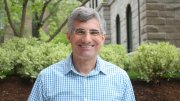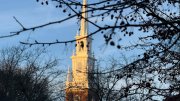Eritrean-born Yohanna Iyasu's parents moved their family to the United Kingdom from Holland when she was 11, hoping for a better education for their children. Although she became fluent in English, her difficulties with the written language caused her to struggle with the Advanced Level exams required for admission to universities; her scores limited her chance of entering an architecture program. Oni Hinton was already on the road to a career in architecture when she became seriously ill during her final years of high school. Her professional dream was put on hold when family troubles compounded the struggles caused by her illness. But this summer, both Iyasu and Hinton have had the chance to pursue their dreams of becoming architects. Along with four other underprivileged British adults—Nick Ackers, Callum Gilbert, Luke Henry-Powell, and Paula McDonald—they are attending the Career Discovery Program, an eight-week introductory course at the Harvard Graduate School of Design (GSD). Their sponsors are the Stephen Lawrence Charitable Trust and the U.K.-based architecture firm RMJM, through the Architecture for Everyone program the two organizations created: a three-year campaign that seeks to increase diversity within the profession.
The chance the six British students have
been given is rare in the field of architecture. According to a research study
conducted in 2004 by the Royal Institute of British Architects, only 2 percent
of practicing architects in Britain are ethnic minorities. Peter Morrison, CEO
of RMJM, publicly warned the architecture community last year that if diversity
in their field did not increase, the creativity level would stagnate. “We need
to reach out today to kids from all backgrounds interested in becoming architects,"
he said. "We need new faces, new ideas, and new ways of looking at the
world. The same old, same old is boring and come 2030, if not already, boring
design will not close the deals on big projects.”
Morrison was in touch with Doreen
Lawrence, who had created the Stephen Lawrence Charitable Trust in honor of her
son, an aspiring architect, who was a victim of racially motivated murder.
Their conversation about how to open up opportunities in the field led to
Architecture for Everyone. That campaign held workshops in inner cities across
the U.K. earlier this year, seeking to attract a diverse and talented group of
potential young architects. Attendees learned about the industry from senior
architects and presented their own designs. Twelve of the most talented
participants at the workshops were invited to a competitive interview, after
which the six winners were chosen.
The Architecture for Everyone program
also reaches out to high-school students. On a trip to London to participate in
a panel discussion connected with the annual Stephen Lawrence Memorial Lecture,
D.K. Osseo-Asare’02, M.Arch ’09, an instructor in the Career Discovery Program,
was encouraged by the tutorials being offered and the work produced by the
students at the Stephen Lawrence Centre. “To have seen the students there and
now to see the six students here, I find it inspiring. It makes me feel
hopeful,” says Osseo-Asare. “You have to start somewhere, and you have to start
with the best.” He champions RMJM’s commitment to increasing diversity in the
profession, despite the recession, and is pleased that their efforts have
garnered attention globally, noting that “What RMJM is doing is relatively
novel. Some large firms sponsor similar initiatives on a case-by-case basis,”
but these smaller-scale efforts “are mainly off the radar.”
Yohanna Iyasu is glad to be able to put Harvard on her résumé because she knows
it will make her a stronger candidate in applying for architecture programs.
Oni Hinton, who was working as a sales assistant at a jewelry shop, cherishes
the opportunity to have her professional passion become a tangible option once
more. “If I hadn’t gotten ill I would be in my third year," she says.
"But now I’m here getting the opportunity to do everything I would have done.”
Peter Morrison’s remarks on the lack of diversity in the field of architecture
can be found in the article “Why architecture must shed its exclusive image”
in The Guardian.








